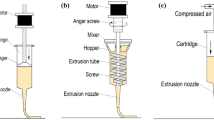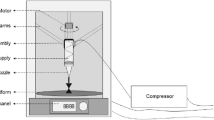Abstract
Three-dimensional (3D) is an emerging technique for the production of various unique and complex food items. Printing materials and recipes should be optimized to improve the quality and efficiency of 3D printing. This paper presents the development of a novel food formulation for 3D printing. This formulation is based on a complex mixture system that comprises egg white protein (EWP), gelatin, cornstarch, and sucrose. The effects of EWP addition on the rheological, lubrication, and texture properties and the microstructure of the mixture system were investigated. The results of the rheological and tribology studies show that a 5.0% (w/w) EWP mixture system is ideal for use in 3D printing. The addition of a certain concentration of EWP could improve the hardness and springiness of gel samples. The improvement in these properties facilitates the timely flow-out of the printing material from the nozzle and improves the viscosity of the printing material. The latter effect helps maintain the shape of the printing material during printing. Furthermore, the printing parameters for the optimal geometric accuracy and dimensions of the printed mixture system were determined and are 1.0 mm nozzle diameter, 70 mm/s nozzle moving speed, and 0.004 cm3/s extrusion rate. This work suggests that 3D printing based on the EWP complex system is a promising method for producing food objects with complex shapes.










Similar content being viewed by others
Change history
03 December 2018
The original version of this article unfortunately do not list the complete authors.
References
Aken, G. A. V. (2010). Modelling texture perception by soft epithelial surfaces. Soft Matter, 6(5), 826–834.
Barrese, R. (2015). Outsourcing becomes ingredient to success: Pasta maker relies on 3PL to provide a variety of special services. (Case Study: New World Pasta). (third party logistics by All Star) (Brief Article). Teaching Theology and Religion, 18, 296–300.
Billiet, T., Vandenhaute, M., Schelfhout, J., Van, V. S., & Dubruel, P. (2012). A review of trends and limitations in hydrogel-rapid prototyping for tissue engineering. Biomaterials, 33(26), 6020–6041.
Chaisawang, M., & Suphantharika, M. (2006). Pasting and rheological properties of native and anionic tapioca starches as modified by guar gum and xanthan gum. Food Hydrocolloids, 20(5), 641–649.
Chang, C., Niu, F., Su, Y., Qiu, Y., Gu, L., & Yang, Y. (2016). Characteristics and emulsifying properties of acid and acid-heat induced egg white protein. Food Hydrocolloids, 54, 342–350.
Chen, J., & Stokes, J. R. (2012). Rheology and tribology: Two distinctive regimes of food texture sensation. Trends in Food Science and Technology, 25(1), 4–12.
Choi, S. S., & Regenstein, J. M. (2010). Physicochemical and sensory characteristics of fish gelatin. Journal of Food Science, 65(2), 194–199.
Dankar, I., Haddarah, A., Omar, F. E. L., Sepulcre, F., & Pujolà, M. (2018). 3D printing technology: The new era for food customization and elaboration. Trends in Food Science and Technology, 75, 231–242.
Das, S., Pelcastre, L., Hardell, J., & Prakash, B. (2013). Effect of static and dynamic ageing on wear and friction behavior of aluminum 6082 alloy. Tribology International, 60(7), 1–9.
Fitzpatrick, P., Meadows, J., Ratcliffe, I., & Williams, P. A. (2013). Control of the properties of xanthan/glucomannan mixed gels by varying xanthan fine structure. Carbohydrate Polymers, 92(2), 1018–1025.
Godoi, F. C., Prakash, S., & Bhandari, B. R. (2016). 3d printing technologies applied for food design: Status and prospects. Journal of Food Engineering, 179, 44–54.
Gross, B. C., Erkal, J. L., Lockwood, S. Y., Chen, C., & Spence, D. M. (2014). Evaluation of 3D printing and its potential impact on biotechnology and the chemical sciences. Analytical Chemistry, 86(7), 3240–3253.
Hao, L., Mellor, S., Seaman, O., Henderson, J., Sewell, N., & Sloan, M. (2010). Material characterisation and process development for chocolate additive layer manufacturing. Virtual and Physical Prototyping, 5(2), 57–64.
Hao, Y., Wang, F., Huang, W., Tang, X., Zou, Q., Li, Z., & Ogawa, A. (2016). Sucrose substitution by polyols in sponge cake and their effects on the foaming and thermal properties of egg protein. Food Hydrocolloids, 57, 153–159.
Holland, S., Foster, T., MacNaughtan, W., & Tuck, C. (2018). Design and characterisation of food grade powders and inks for microstructure control using 3D printing. Journal of Food Engineering, 220, 12–19.
Hu, Y., Liang, H., Xu, W., Wang, Y., An, Y., Yan, X., Ye, S., Huang, Q., Liu, J., & Li, B. (2016). Synergistic effects of small amounts of konjac glucomannan on functional properties of egg white protein. Food Hydrocolloids, 52(3), 213–220.
Huang, T., Tu, Z. C., Wang, H., Shangguan, X., Zhang, L., Niu, P., & Sha, X. M. (2017). Promotion of foam properties of egg white protein by subcritical water pre-treatment and fish scales gelatin. Colloids and Surfaces A Physicochemical and Engineering Aspects, 512, 171–177.
Ivanova, O., Williams, C., & Campbell, T. (2013). Additive manufacturing (am) and nanotechnology: Promises and challenges. Rapid Prototyping Journal, 19(5), 353–364.
Kalsoom, U., Nesterenko, P. N., & Paull, B. (2016). Recent developments in 3d printable composite materials. RSC Advances, 6(65), 60355–60371.
Kjeldskov, J., Nielsen, T. S., Skov, M. B., & Paay, J. (2014). EyeGaze: enabling eye contact over video. International Working Conference on Advanced Visual Interfaces, 105–112.
Kruif, C. G. D., & Tuinier, R. (2001). Polysaccharide protein interactions. Food Hydrocolloids, 15(4), 555–563.
Lam, C. X. F., Mo, X. M., Teoh, S. H., & Hutmacher, D. W. (2002). Scaffold development using 3D printing with a starch-based polymer. Materials Science and Engineering C, 20(1-2), 49–56.
Lanaro, M., Forrestal, D. P., Scheurer, S., Slinger, D. J., Liao, S., Powell, S. K., & Woodruff, M. A. (2017). 3D printing complex chocolate objects: Platform design, optimization and evaluation. Journal of Food Engineering, 215, 13–22.
Lassé, M., Deb-Choudhury, S., Haines, S., Larsen, N., Gerrard, J. A., & Dyer, J. M. (2015). The impact of pH, salt concentration and heat on digestibility and amino acid modification in egg white protein. Journal of Food Composition and Analysis, 38, 42–48.
Li, H., Zhao, L., Chen, X. D., & Mercadé-Prieto, R. (2016). Swelling of whey and egg white protein hydrogels with stranded and particulate microstructures. International Journal of Biological Macromolecules, 83, 152–159.
Lipton, J. I., Cutler, M., Nigl, F., Dan, C., & Lipson, H. (2015). Additive manufacturing for the food industry. Trends in Food Science and Technology, 43(1), 114–123.
Liu, H. B., Liu, J., & Wang, L. (2008). Searching maximum quasi-bicliques from protein-protein interaction network. Journal of Biomedical Science and Engineering, 1(3), 200–203.
Liu, Z., Zhang, M., Bhandari, B., & Wang, Y. (2017). 3D printing: Printing precision and application in food sector. Trends in Food Science & Technology, 69, 83–94.
Liu, Z., Zhang, M., Bhandari, B., & Yang, C. (2018). Impact of rheological properties of mashed potatoes on 3D printing. Journal of Food Engineering, 220, 76–82.
Majumdar, S., Trujilloreyes, J., Hernandezviezcas, J. A., White, J. C., Peraltavidea, J. R., & Gardeatorresdey, J. L. (2016). Cerium biomagnification in a terrestrial food chain: Influence of particle size and growth stage. Environmental Science and Technology, 50, 67–82.
Mantihal, S., Prakash, S., Godoi, F. C., & Bhandari, B. (2017). Optimization of chocolate 3d printing by correlating thermal and flow properties with 3d structure modeling. Innovative Food Science & Emerging Technologies, 44, 21–29.
Nguyen, P. T. M., Bhandari, B., & Prakash, S. (2016). Tribological method to measure lubricating properties of dairy products. Journal of Food Engineering, 168, 27–34.
Ninan, G., Joseph, J., & Aliyamveettil, Z. A. (2014). A comparative study on the physical, chemical and functional properties of carp skin and mammalian gelatins. Journal of Food Science and Technology, 51(9), 2085–2091.
Phillips, G. O., & Williams, P. A. (2011). Introduction to food proteins. In Handbook of food proteins (p. 1). Woodhead Publishing.
Prakash, S., Tan, D. D. Y., & Chen, J. (2013). Applications of tribology in studying food oral processing and texture perception. Food Research International, 54(2), 1627–1635.
Raikos, V., Campbell, L., & Euston, S. R. (2007a). Effects of sucrose and sodium chloride on foaming properties of egg white proteins. Food Research International, 40(3), 347–355.
Raikos, V., Campbell, L., & Euston, S. R. (2007b). Rheology and texture of hen's egg protein heat-set gels as affected by pH and the addition of sugar and/or salt. Food Hydrocolloids, 21(2), 237–244.
Scaraggi, M., & Persson, B. N. J. (2014). Theory of viscoelastic lubrication. Tribology International, 72(4), 118–130.
Selway, N., & Stokes, J. R. (2013). Insights into the dynamics of oral lubrication and mouthfeel using soft tribology: Differentiating semi-fluid foods with similar rheology. Food Research International, 54(1), 423–431.
Shiroodi, S. G., Rasco, B. A., & Lo, Y. M. (2015). Influence of xanthan–curdlan hydrogel complex on freeze-thaw stability and rheological properties of whey protein isolate gel over multiple freeze-thaw cycle. Journal of Food Science, 80(7), E1498–E1505.
Spotti, M. J., Perduca, M. J., Piagentini, A., Santiago, L. G., Rubiolo, A. C., & Carrara, C. R. (2013). Gel mechanical properties of milk whey protein–dextran conjugates obtained by Maillard reaction. Food Hydrocolloids, 3(1), 26–32.
Sun, J., Peng, Z., Yan, L., Fuh, J., & Hong, G. S. (2015a). 3d food printing—An innovative way of mass customization in food fabrication. International Journal of Bioprinting, 1(1), 27–38.
Sun, J., Peng, Z., Zhou, W., Fuh, J. Y. H., Hong, G. S., & Chiu, A. (2015b). A review on 3D printing for customized food fabrication. Procedia Manufacturing, 1, 308–319.
Sun, J., Zhou, W., Huang, D., Fuh, J. Y. H., & Hong, G. S. (2015c). An overview of 3d printing technologies for food fabrication. Food and Bioprocess Technology, 8(8), 1605–1615.
Tohic, C. L., O’Sullivan, J. J., Drapala, K. P., Chartrin, V., Chan, T., Morrison, A. P., Kerry, J. P., & Kelly, A. L. (2017). Effect of 3d printing on the structure and textural properties of processed cheese. Journal of Food Engineering, 220, 56–64.
Upadhyay, R., Brossard, N., & Chen, J. (2016). Mechanisms underlying astringency: Introduction to an oral tribology approach. Journal of Physics D Applied Physics, 49(10), 104003.
Vogeler, F., Verheecke, W., Voet, A., & Valkenaers, H. (2013). An initial study of aerosol jet® printed interconnections on extrusion-based 3d-printed substrates. Journal of Mechanical Engineering, 59(11), 689–696.
Wang, L., Zhang, M., Bhandari, B., & Yang, C. (2017). Investigation on fish surimi gel as promising food material for 3d printing. Journal of Food Engineering, 220, 101–108.
Wegrzyn, T. F., Golding, M., & Archer, R. H. (2012). Food layered manufacture: A new process for constructing solid foods. Trends in Food Science and Technology, 27(2), 66–72.
Wu, Y., Wu, X., Yao, L., Xue, Z., Wu, C., Zhou, H., & Cen, K. (2017). Simultaneous particle size and 3d position measurements of pulverized coal flame with digital inline holography. Fuel, 195, 12–22.
Yang, Y., Chen, Y., Wei, Y., & Li, Y. (2016). 3d printing of shape memory polymer for functional part fabrication. International Journal of Advanced Manufacturing Technology, 84(9–12), 2079–2095.
Yang, F., Zhang, M., & Bhandari, B. (2017). Recent development in 3D food printing. Critical Reviews in Food Science and Nutrition, 57(14), 3145–3153.
Yun, L., Man, L., Ke-Xue, Z., Xiao-Na, G., Wei, P., & Hui-Ming, Z. (2016). Heat-induced interaction between egg white protein and wheat gluten. Food Chemistry, 197, 699–708.
Zhou, P., Guo, M., Liu, D., Liu, X., & Labuza, T. P. (2013). Maillard-reaction-induced modification and aggregation of proteins and hardening of texture in protein bar model systems. Journal of Food Science, 78(3), C437–C444.
Zhu, Y., Bhandari, B., & Prakash, S. (2018). Tribo-rheometry behaviour and gel strength of κ-carrageenan and gelatin solutions at concentrations, pH and ionic conditions used in dairy products. Food Hydrocolloids, 84, 292–302.
Acknowledgments
The authors thank Prof. Bhesh Bhandari and Dr. Sangeeta Prakash for their valuable comments and discussion.
Funding
This study was supported by Natural Science Foundation of China (No. U1704114), and Key Scientific Research Program of Henan Province (No.161100110900, 161100110600-2, and 161100110700-2).
Author information
Authors and Affiliations
Corresponding authors
Rights and permissions
About this article
Cite this article
Liu, L., Meng, Y., Dai, X. et al. 3D Printing Complex Egg White Protein Objects: Properties and Optimization. Food Bioprocess Technol 12, 267–279 (2019). https://doi.org/10.1007/s11947-018-2209-z
Received:
Accepted:
Published:
Issue Date:
DOI: https://doi.org/10.1007/s11947-018-2209-z




